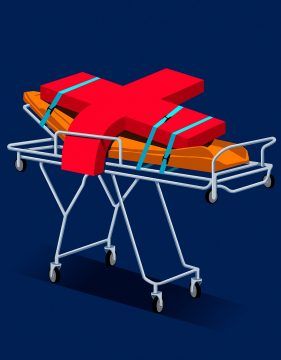Siddhartha Mukherjee in The New Yorker:
 At 4:18 a.m. on February 1, 1997, a fire broke out in the Aisin Seiki company’s Factory No. 1, in Kariya, a hundred and sixty miles southwest of Tokyo. Soon, flames had engulfed the plant and incinerated the production line that made a part called a P-valve—a device used in vehicles to modulate brake pressure and prevent skidding. The valve was small and cheap—about the size of a fist, and roughly ten dollars apiece—but indispensable. The Aisin factory normally produced almost thirty-three thousand valves a day, and was, at the time, the exclusive supplier of the part for the Toyota Motor Corporation. Within hours, the magnitude of the loss was evident to Toyota. The company had adopted “just in time” (J.I.T.) production: parts, such as P-valves, were produced according to immediate needs—to precisely match the number of vehicles ready for assembly—rather than sitting around in stockpiles. But the fire had now put the whole enterprise at risk: with no inventory in the warehouse, there were only enough valves to last a single day. The production of all Toyota vehicles was about to grind to a halt. “Such is the fragility of JIT: a surprise event can paralyze entire networks and even industries,” the management scholars Toshihiro Nishiguchi and Alexandre Beaudet observed the following year, in a case study of the episode.
At 4:18 a.m. on February 1, 1997, a fire broke out in the Aisin Seiki company’s Factory No. 1, in Kariya, a hundred and sixty miles southwest of Tokyo. Soon, flames had engulfed the plant and incinerated the production line that made a part called a P-valve—a device used in vehicles to modulate brake pressure and prevent skidding. The valve was small and cheap—about the size of a fist, and roughly ten dollars apiece—but indispensable. The Aisin factory normally produced almost thirty-three thousand valves a day, and was, at the time, the exclusive supplier of the part for the Toyota Motor Corporation. Within hours, the magnitude of the loss was evident to Toyota. The company had adopted “just in time” (J.I.T.) production: parts, such as P-valves, were produced according to immediate needs—to precisely match the number of vehicles ready for assembly—rather than sitting around in stockpiles. But the fire had now put the whole enterprise at risk: with no inventory in the warehouse, there were only enough valves to last a single day. The production of all Toyota vehicles was about to grind to a halt. “Such is the fragility of JIT: a surprise event can paralyze entire networks and even industries,” the management scholars Toshihiro Nishiguchi and Alexandre Beaudet observed the following year, in a case study of the episode.
Toyota’s response was extraordinary: by six-thirty that morning, while the factory was still smoldering, executives huddled to organize the production of P-valves at other factories. It was a “war room,” one official recalled. The next day, a Sunday, small and large factories, some with no direct connection to Toyota, or even to the automotive industry, received detailed instructions for manufacturing the P-valves. By February 4th, three days after the fire, many of these factories had repurposed their machines to make the valves. Brother Industries, a Japanese company best known for its sewing machines and typewriters, adapted a computerized milling device that made typewriter parts to start making P-valves. The ad-hoc work-around was inefficient—it took fifteen minutes to complete each valve, its general manager admitted—but the country’s largest company was in trouble, and so the crisis had become a test of national solidarity. All in all, Toyota lost some seventy thousand vehicles—an astonishingly small number, given the millions of orders it fulfilled that year. By the end of the week, it had increased shifts and lengthened hours. Within the month, the company had rebounded.
Every enterprise learns its strengths and weaknesses from an Aisin-fire moment—from a disaster that spirals out of control. What those of us in the medical profession have learned from the covid-19 crisis has been dismaying, and on several fronts. Medicine isn’t a doctor with a black bag, after all; it’s a complex web of systems and processes. It is a health-care delivery system—providing antibiotics to a child with strep throat or a new kidney to a patient with renal failure. It is a research program, guiding discoveries from the lab bench to the bedside. It is a set of protocols for quality control—from clinical-practice guidelines to drug and device approvals. And it is a forum for exchanging information, allowing for continuous improvement in patient care. In each arena, the pandemic has revealed some strengths—including frank heroism and ingenuity—but it has also exposed hidden fractures, silent aneurysms, points of fragility. Systems that we thought were homeostatic—self-regulating, self-correcting, like a human body in good health—turned out to be exquisitely sensitive to turbulence, like the body during critical illness. Everyone now asks: When will things get back to normal? But, as a physician and researcher, I fear that the resumption of normality would signal a failure to learn. We need to think not about resumption but about revision.
More here.
